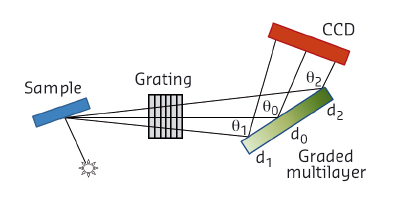- Home
- Users & Science
- Scientific Documentation
- ESRF Highlights
- ESRF Highlights 2015
- Electronic structure, magnetism and dynamics
- Fully-polarised soft X-ray RIXS at the ESRF
Fully-polarised soft X-ray RIXS at the ESRF
Simultaneous measurements of energy and polarisation of the scattered X-rays has been made using soft X-ray RIXS (resonant inelastic X-ray scattering) for the first time. For high temperature superconductors of the yttrium barium copper oxide (YBCO) family the results were instrumental in demonstrating the collective nature of the magnetic excitations.
Copper-based high-critical-temperature superconductors (HTcS) have a layered structure, for which the fundamental building units are CuO2 planes that have a square lattice with spin 1/2 Cu2+ ions bound to oxygen. The superconductivity arises upon doping either with holes or electrons. The antiferromagnetic coupling of Cu, typical of the undoped parent compound, is not destroyed in the short range upon doping. Therefore, to assess whether the low energy magnetic excitations are collective or band-like is of great interest for the long standing debate on high Tc superconductivity. In ref. [1] the collective nature of magnetic excitations in the YBCO family was demonstrated with RIXS. Indeed RIXS can be thought of as resonant Raman scattering and the observation of a constant energy-loss at increasing incident energy rules out the band-like picture that would lead to constant emitted-energy. The experiment is complicated by the superposition of the magnetic peaks with non-magnetic excitations. Due to angular momentum conservation, spin excitations are characterised by the change of the linear polarisation of the scattered light, as shown in Figure 48 and explained in [1]. In effect, in two superconducting YBa2Cu3O6+δ samples, the full analysis of the polarisation of the scattered X-rays demonstrates that the spectra with π incident polarisation, at large positive wave-vector, are largely dominated by a crossed polarisation process, which is the fingerprint of spin excitations (Figure 48, a and b). The measurements vs. incident energy were made at the Swiss Light Source (SLS), without observing the outgoing polarisation, while the spectra with full control of the polarisation discussed here were taken at the ESRF.
 |
|
Fig. 48: Polarisation-resolved RIXS spectra from underdoped (left; p = 0.062) and overdoped (right, p = 0.21) YBCO. Scattering angle 130° and near normal incidence. The spectra were measured by tuning the photon energy to the peak of the Cu L3 absorption. |
RIXS has recently become a powerful approach, cross fertilising with neutrons, and having the great advantage of being possible on very small amounts of material down to a layer of a single unit cell of a cuprate. Normally, the polarisation of the scattered photons is not measured in the soft X-ray range and this is one of the most severe limitations at present. This is largely due to polarisation analysis being a real technical challenge. Starting in 2011, at beamline ID08, a preliminary prototype of a polarimeter (used in [1]) was designed, realised, field tested and progressively improved, using the AXES spectrometer available at that time for RIXS. The work was carried out jointly by a team from the Politecnico di Milano (Italy) and by ESRF staff [2]. The polarimeter works as shown schematically in Figure 49. Inside the spectrometer, a plane multilayer mirror deflects the beam by a large angle (~40 deg), so that the s and p components of linear polarisation are reflected with significantly different efficiency. An appropriate linear combination of the spectra measured with and without the multilayer provides the polarisation-resolved RIXS spectra. This valuable information comes at the price of a loss in intensity of more than a factor 10 in the prototype. The major technical difficulty is given by the horizontal divergence of the beam coming from the sample, which requires a graded multilayer to accept a sizeable horizontal aperture. The system has an energy bandpass of about 1.5 eV and it goes rapidly out of tune when changing energy.
 |
|
Fig. 49: Schematic of the apparatus used in the measurements given in Figure 48. |
In the meantime, the new beamline ID32 has been equipped with an 11 metre RIXS spectrometer. Its first mirror collimates the radiation horizontally, so that the new polarimeter has a vertical gradient matching the grating dispersion as suggested in [2] and ensuring a flat bandpass of at least 10 eV. Preliminary tests at the Cu L3 edge gave good results with 11000 resolving power. Note that, without the polarimeter, the instrument can provide a resolving power of up to 30000.
Principal publications and authors
[1] Collective nature of spin excitations in superconducting cuprates probed by resonant inelastic X-ray scattering, M. Minola (a), G. Dellea (b), H. Gretarsson (a), Y.Y. Peng (b), Y. Lu (a), J. Porras (a), T. Loew (a), F. Yakhou (c), N.B. Brookes (c), Y.B. Huang (d), J. Pelliciari (d), T. Schmitt (d), G. Ghiringhelli (b), B. Keimer (a), L. Braicovich (b) and M. LeTacon (a), Physical Review Letters 114, 217003 (2015); doi: 10.1103/PhysRevLett.114.217003.
(a) Max-Planck-Institut fur Festkorperforschung, Stuttgart (Germany)
(b) CNISM, CNR-SPIN and Dipartimento di Fisica, Politecnico di Milano (Italy)
(c) ESRF
(d) Swiss Light Source, Paul Scherrer Institut, Villigen (Switzerland)
[2] The simultaneous measurement of energy and linear polarization of the scattered radiation in resonant inelastic soft X-ray scattering, L. Braicovich (a), M. Minola (b), G. Dellea (a), M. LeTacon (b), M. MorettiSala (c), C. Morawe (c), J.C. Peffen (c), R. Supruangnet (c), F. Yakhou (c), G. Ghiringhelli (a) and N.B. Brookes (c), Review of Scientific Instruments 85, 115104 (2014); doi: 10.1063/1.4900959.
(a) CNISM, CNR-SPIN and Dipartimento di Fisica, Politecnico di Milano (Italy)
(b) Max-Planck-Institut fur Festkorperforschung, Stuttgart (Germany)
(c) ESRF



